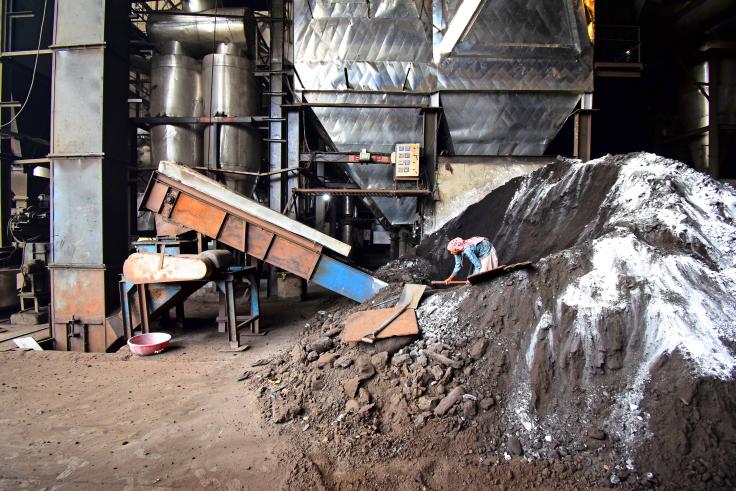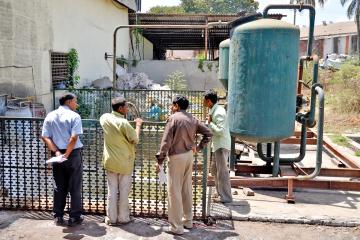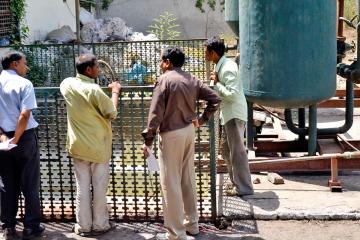
How India used cap-and-trade to reduce pollution and improve health.

Policymakers and funders should scale emissions markets to improve air quality in low- and middle-income countries. In Gujarat, a market-based approach to pollution control cut industrial emissions by 20-30 percent while lowering costs to businesses, and is now improving air quality for over 15 million people.
A similar approach can work with other types of harmful emissions. For example, water pollution markets may be effective at improving water quality, and carbon markets for mitigating climate change.
Existing pollution controls are failing to protect public health. Outdoor air pollution kills an estimated 5.7 million people worldwide each year. In industrial regions across India, dangerous levels of particulate matter in the air cut the average Indian’s life expectancy by over five years. Traditional environmental regulations can face weak enforcement and costly compliance that make them ineffective in practice. Tweaks to the system like introducing independent auditors or better monitoring data can help, but can only go so far.
A pioneering emissions market offers a new approach. Emissions markets have reduced pollution and carbon emissions in high-income settings, but are rarely used in low- and middle-income countries. Indian regulators in the state of Gujarat piloted the world’s first cap-and-trade market for particulate matter in partnership with researchers, J-PAL South Asia, and EPIC India. The market system set a cap on emissions and let factories buy and sell permits within this limit. Factories that can reduce pollution cheaply can sell their excess permits to others. The total amount of pollution stays under the cap, but factories now have a reason to clean up: If they pollute less, they can make money by selling permits. If they pollute more than the allowable amount, they can either buy more permits or face automatic fines.
The market worked—and at lower cost to industry than expected. Participating factories cut their emissions by 20 to 30 percent relative to those under traditional regulations. Strikingly, these reductions came with lower costs of compliance. Many factories already had pollution control equipment, but weren’t using it. The market incentives changed that.
The health benefits far outweighed the costs. Even though the pilot market covered just a fraction of pollution sources, the public health gains from lowering mortality rates were large. Researchers estimate that over time, we can expect the reduction in pollution to increase life expectancy by almost one year. Six years after the market was launched, the total benefits from reduced pollution are worth more than 25 times the implementation costs.
Now, the model is scaling to improve air quality for more people. Backed by strong government leadership and research collaboration, Gujarat has expanded the market to cover over 15 million people, and the approach is continuing to expand to more cities and states in India. Other governments should take note: emissions markets can work, even in contexts where the government has a limited capacity to monitor and enforce pollution regulation.
Cost and design considerations
Cap-and-trade emissions markets are a high-impact, low-cost policy for cleaner air. The pilot market in Surat was exceptionally cost-effective: Researchers estimated that the health benefits exceeded the costs by at least 25 times. The program didn’t require companies to buy new technology—most already had pollution-reducing equipment but were underusing it.
Transparent data is essential for effective enforcement and scale. Companies were required to set up and run continuous emissions monitoring systems (CEMS), which enabled enforcement and transparency. CEMS played a critical role: real-time data created both accountability and flexibility. Factories could adjust behavior or trade permits to stay within limits. Fines for exceeding limits were automatic and proportionate, making enforcement feasible in settings where monitoring is challenging. To adapt this approach, policymakers should prioritize high-quality data systems, simple and credible enforcement rules, and technical assistance for regulators.
The benefits of cap-and-trade go well beyond air pollution. Since 2005, the EU has used an international carbon market to reduce greenhouse gas emissions, and California’s cap-and-trade program has been running since 2013. Beyond emissions reductions in the air, market mechanisms can be used to curb water pollution, another global challenge disproportionately affecting low-income populations.
Transparent data is essential for effective enforcement and scale.
Implementing partners
Implementers bring deep local knowledge, technical expertise, and a commitment to evaluation and learning as they bring these programs to life. Many organizations run evidence-informed unconditional cash transfer programs, including the following (listed in alphabetical order); this list is not exhaustive.

The Government of Gujarat played a pioneering role in developing and scaling the pollution emissions market. In 2009, local regulators took an important first step by partnering with researchers to improve the reliability of industrial audits. Introducing more independent auditors led to a 28 percent reduction in pollution and was integrated into Gujarat’s statewide audit system. But even with better audits and some reduction in pollution, overall pollution levels were still too high.
India’s regulators needed a solution that matched the scale of the challenge—and the constraints of enforcement capacity. Regulators worked closely with researchers and technical partners to design the trading system, set emissions caps, and enforce compliance. The Gujarat Pollution Control Board established the data collection system to monitor emissions (CEMS), launched the market in Surat, and expanded it to other cities, including Ahmedabad.
“As the regulator, we have worked closely with industry and research partners to build and implement a system that delivers measurable environmental gains with minimal cost to businesses. The 20–30% reduction in emissions… demonstrates the promise of market-based instruments in achieving regulatory goals efficiently."
—Mr. D.M. Thakar, Member Secretary, Gujarat Pollution Control Board
The role of foreign assistance and philanthropy
Strategic philanthropic investment can make it easier for governments to rigorously test and scale innovative, market-based tools that address major regional challenges. Funding from King Philanthropies, through J-PAL’s King Climate Action Initiative (K-CAI), supported rigorous impact evaluation and enabled the first scale-up of the emissions market to new cities, with additional support from J-PAL’s Solutions and Advancements through Research for Water and Air (SARWA) to further expand in Gujarat and other states.
J-PAL’s Alliance for Scaling Policy Impact through Research and Evidence (ASPIRE) and other funders provided technical and operational support for further evaluation and scaling. The long-term collaboration between J-PAL researchers and the Government of Gujarat helped ensure that lessons from the research informed real-world decisions at every stage.
Discover more from J-PAL
Strengthening third-party audits to reduce pollution
Discover more from other sources
Photos:
(1) Credit: Shutterstock.com
(2) Credit: EPIC India




